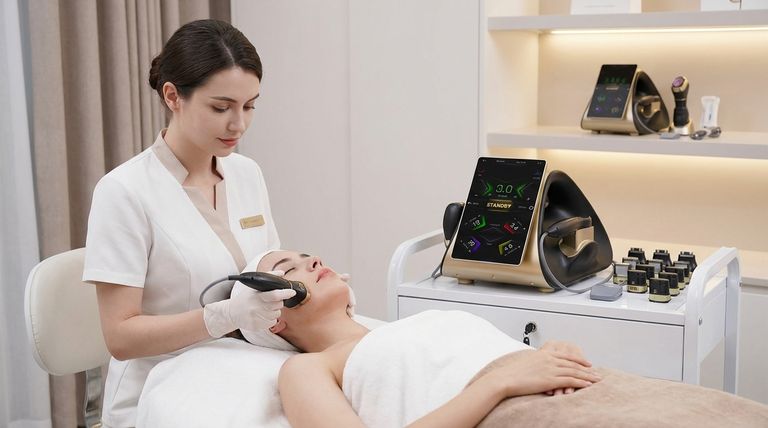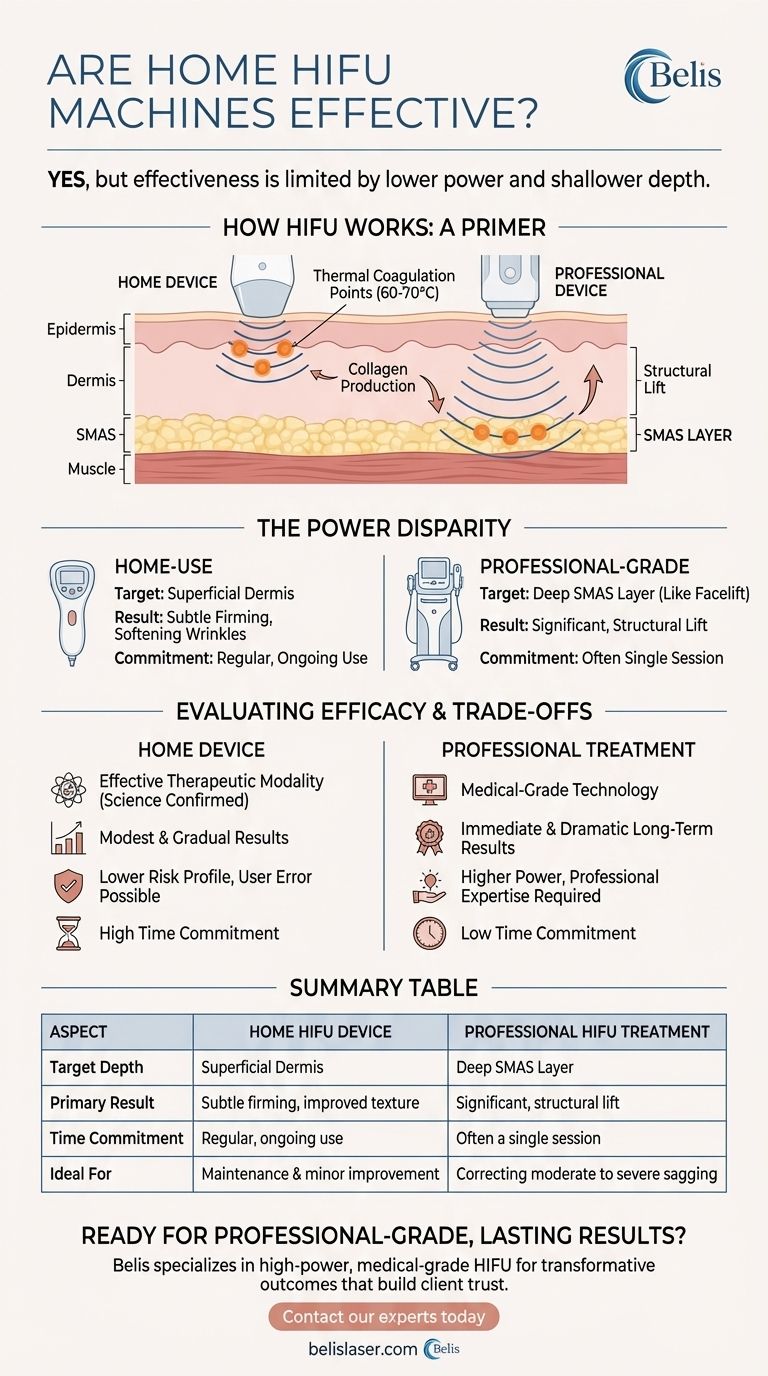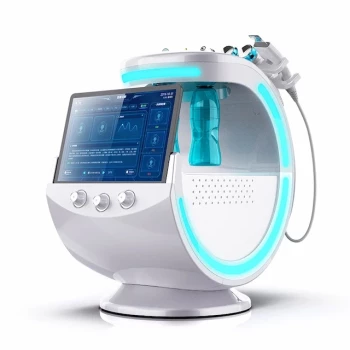Yes, a home-use HIFU machine can be an effective tool for skin tightening. Based on clinical evidence, these devices are capable of inducing measurable improvements in skin laxity. However, their effectiveness is fundamentally limited by their lower power and shallower treatment depth compared to professional-grade equipment.
The critical distinction is not whether home HIFU devices work, but the degree to which they work. They offer a modest, superficial tightening effect, whereas professional treatments deliver a significant, structural lift by targeting deeper tissue layers.

How HIFU Works: A Primer on Focused Ultrasound
High-Intensity Focused Ultrasound (HIFU) is a non-invasive technology that uses sound waves to generate heat in specific layers of the skin. This controlled thermal injury is the key to its rejuvenating effects.
The Principle of Thermal Coagulation
HIFU devices focus ultrasound energy to create precise points of heat, known as thermal coagulation points, at a specific depth beneath the skin's surface. This process heats the tissue to approximately 60-70°C, which triggers two primary responses: immediate tissue contraction and a long-term healing response that stimulates new collagen production.
Professional vs. Home Devices: The Power Disparity
The single most important factor determining results is the machine's ability to deliver energy to the correct depth.
Professional devices are powerful enough to target the SMAS layer (Superficial Muscular Aponeurotic System), the same foundational layer of tissue addressed in a surgical facelift. Treating this layer is what produces a visible, structural lift.
Home-use devices operate at a much lower energy level for safety reasons. They cannot safely or effectively reach the SMAS layer and instead work on the more superficial dermal layers to stimulate collagen.
Evaluating the Efficacy of a Home Device
While a home device won't replicate a clinical treatment, it can provide tangible benefits if your expectations are properly calibrated.
What the Science Says
Studies have confirmed that home-use HIFU devices can be an effective therapeutic modality for skin tightening. Users often see improvements in skin texture, firmness, and the appearance of fine lines over time.
The Target: Superficial Firming
The realistic goal for a home HIFU device is a subtle firming of the skin and a softening of superficial wrinkles. It works by improving the health and density of the dermis, not by repositioning underlying facial structures.
The Outcome: Modest and Gradual Results
Results from a home device are not immediate or dramatic. They appear gradually over weeks and months of consistent and correct use. The improvement is best described as a mild tightening and enhanced skin quality.
Understanding the Trade-offs and Risks
The primary benefit of a home device is also its main limitation: its lower power makes it safer for consumer use but also significantly less potent.
The Safety Profile
Because they deliver less energy and treat at a shallower depth, home devices have a much lower risk profile than professional machines. Common side effects are minimal and temporary, such as slight redness or swelling.
The Risk of Improper Use
Despite being designed for safety, user error is still a risk. Over-treating an area, using the device improperly, or failing to use the required conductive gel can potentially lead to skin irritation or burns. Following the manufacturer's instructions precisely is non-negotiable.
The Commitment Factor: Time and Consistency
A professional HIFU treatment is often a single session with results that last a year or more. A home device requires an ongoing commitment of regular sessions, often multiple times per week, to build and maintain results. This time investment is a significant trade-off to consider.
Making the Right Choice for Your Goal
To determine if a home HIFU device is right for you, you must first be clear about your desired outcome.
- If your primary focus is a significant, visible lift and correction of moderate to severe sagging: Professional, in-clinic HIFU or other medical-grade treatments are the only effective options.
- If your primary focus is subtle maintenance, improving skin texture, or achieving minor firming: A home-use device can be a worthwhile investment, provided you are committed to using it consistently.
- If you are unsure or have underlying skin conditions: Always consult with a board-certified dermatologist before beginning any new at-home energy-based treatment.
Understanding the fundamental difference in technological capability is the key to investing your time and money wisely.
Summary Table:
| Aspect | Home HIFU Device | Professional HIFU Treatment |
|---|---|---|
| Target Depth | Superficial dermis | Deep SMAS layer (like a facelift) |
| Primary Result | Subtle firming, improved texture | Significant, structural lift |
| Time Commitment | Regular, ongoing use | Often a single session |
| Ideal For | Maintenance & minor improvement | Correcting moderate to severe sagging |
Ready for professional-grade, lasting results?
While home devices offer subtle benefits, only professional equipment can deliver the significant lift your clients expect. BELIS specializes in high-power, medical-grade HIFU machines designed specifically for clinics and premium salons. Our technology safely targets the deep SMAS layer for transformative outcomes that build client trust and loyalty.
Contact our experts today to discover the right professional solution for your business.
Visual Guide

Related Products
- 22D HIFU Machine Device Facial Machine
- 7D 12D 4D HIFU Machine Device
- 12D HIFU Machine Device for Facial HIFU Treatment
- 4D 12D HIFU Machine Device for Skin Tightening and Lifting
- 4D 12D HIFU Machine Device for Skin Tightening
People Also Ask
- How do I maximize my HIFU results? A Guide to Optimal Lifting and Tightening
- How long does it take for HIFU to show results? See the Dual-Phase Timeline for Natural Lifting
- How frequently should you do HIFU? Optimize Your Results with the Right Schedule
- What are the benefits of HIFU machine? Achieve Non-Surgical Skin Lifting & Tightening
- How does HIFU tighten the skin? The Science Behind Non-Surgical Lifting



















